Nanning Zheng
Xi'an Jiaotong University
StructVPR++: Distill Structural and Semantic Knowledge with Weighting Samples for Visual Place Recognition
Mar 09, 2025Abstract:Visual place recognition is a challenging task for autonomous driving and robotics, which is usually considered as an image retrieval problem. A commonly used two-stage strategy involves global retrieval followed by re-ranking using patch-level descriptors. Most deep learning-based methods in an end-to-end manner cannot extract global features with sufficient semantic information from RGB images. In contrast, re-ranking can utilize more explicit structural and semantic information in one-to-one matching process, but it is time-consuming. To bridge the gap between global retrieval and re-ranking and achieve a good trade-off between accuracy and efficiency, we propose StructVPR++, a framework that embeds structural and semantic knowledge into RGB global representations via segmentation-guided distillation. Our key innovation lies in decoupling label-specific features from global descriptors, enabling explicit semantic alignment between image pairs without requiring segmentation during deployment. Furthermore, we introduce a sample-wise weighted distillation strategy that prioritizes reliable training pairs while suppressing noisy ones. Experiments on four benchmarks demonstrate that StructVPR++ surpasses state-of-the-art global methods by 5-23% in Recall@1 and even outperforms many two-stage approaches, achieving real-time efficiency with a single RGB input.
ForestLPR: LiDAR Place Recognition in Forests Attentioning Multiple BEV Density Images
Mar 06, 2025Abstract:Place recognition is essential to maintain global consistency in large-scale localization systems. While research in urban environments has progressed significantly using LiDARs or cameras, applications in natural forest-like environments remain largely under-explored. Furthermore, forests present particular challenges due to high self-similarity and substantial variations in vegetation growth over time. In this work, we propose a robust LiDAR-based place recognition method for natural forests, ForestLPR. We hypothesize that a set of cross-sectional images of the forest's geometry at different heights contains the information needed to recognize revisiting a place. The cross-sectional images are represented by \ac{bev} density images of horizontal slices of the point cloud at different heights. Our approach utilizes a visual transformer as the shared backbone to produce sets of local descriptors and introduces a multi-BEV interaction module to attend to information at different heights adaptively. It is followed by an aggregation layer that produces a rotation-invariant place descriptor. We evaluated the efficacy of our method extensively on real-world data from public benchmarks as well as robotic datasets and compared it against the state-of-the-art (SOTA) methods. The results indicate that ForestLPR has consistently good performance on all evaluations and achieves an average increase of 7.38\% and 9.11\% on Recall@1 over the closest competitor on intra-sequence loop closure detection and inter-sequence re-localization, respectively, validating our hypothesis
HRVMamba: High-Resolution Visual State Space Model for Dense Prediction
Oct 04, 2024Abstract:Recently, State Space Models (SSMs) with efficient hardware-aware designs, i.e., Mamba, have demonstrated significant potential in computer vision tasks due to their linear computational complexity with respect to token length and their global receptive field. However, Mamba's performance on dense prediction tasks, including human pose estimation and semantic segmentation, has been constrained by three key challenges: insufficient inductive bias, long-range forgetting, and low-resolution output representation. To address these challenges, we introduce the Dynamic Visual State Space (DVSS) block, which utilizes multi-scale convolutional kernels to extract local features across different scales and enhance inductive bias, and employs deformable convolution to mitigate the long-range forgetting problem while enabling adaptive spatial aggregation based on input and task-specific information. By leveraging the multi-resolution parallel design proposed in HRNet, we introduce High-Resolution Visual State Space Model (HRVMamba) based on the DVSS block, which preserves high-resolution representations throughout the entire process while promoting effective multi-scale feature learning. Extensive experiments highlight HRVMamba's impressive performance on dense prediction tasks, achieving competitive results against existing benchmark models without bells and whistles. Code is available at https://github.com/zhanghao5201/HRVMamba.
Neural P$^3$M: A Long-Range Interaction Modeling Enhancer for Geometric GNNs
Sep 26, 2024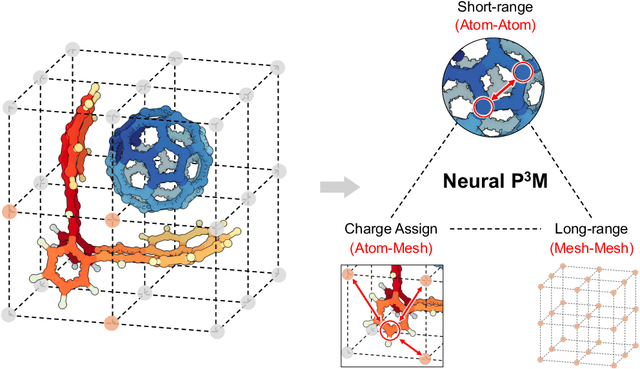
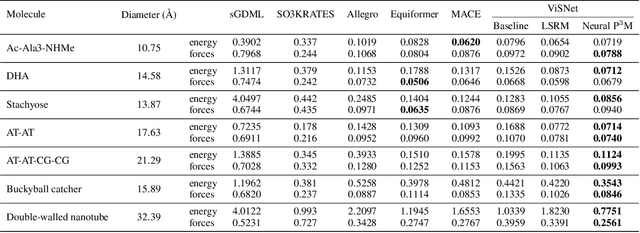
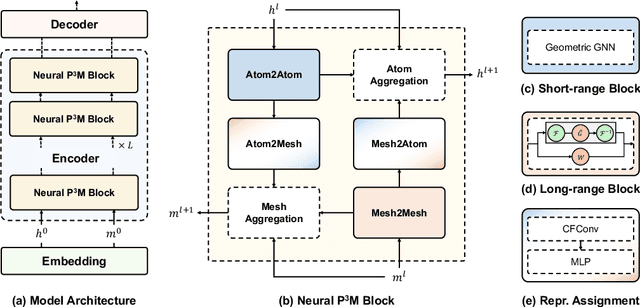
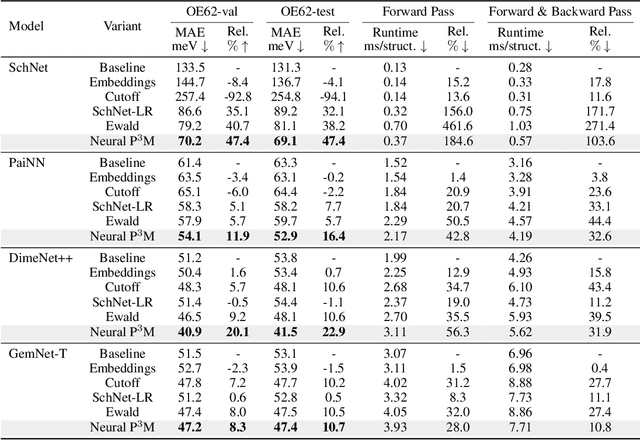
Abstract:Geometric graph neural networks (GNNs) have emerged as powerful tools for modeling molecular geometry. However, they encounter limitations in effectively capturing long-range interactions in large molecular systems. To address this challenge, we introduce Neural P$^3$M, a versatile enhancer of geometric GNNs to expand the scope of their capabilities by incorporating mesh points alongside atoms and reimaging traditional mathematical operations in a trainable manner. Neural P$^3$M exhibits flexibility across a wide range of molecular systems and demonstrates remarkable accuracy in predicting energies and forces, outperforming on benchmarks such as the MD22 dataset. It also achieves an average improvement of 22% on the OE62 dataset while integrating with various architectures.
DexDiff: Towards Extrinsic Dexterity Manipulation of Ungraspable Objects in Unrestricted Environments
Sep 09, 2024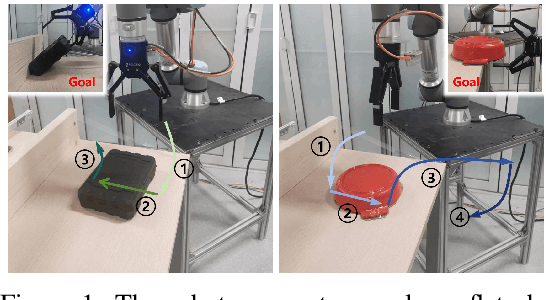

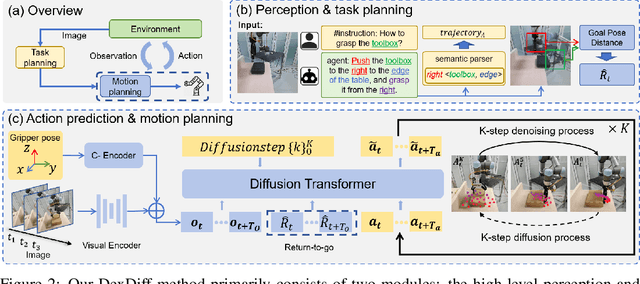

Abstract:Grasping large and flat objects (e.g. a book or a pan) is often regarded as an ungraspable task, which poses significant challenges due to the unreachable grasping poses. Previous works leverage Extrinsic Dexterity like walls or table edges to grasp such objects. However, they are limited to task-specific policies and lack task planning to find pre-grasp conditions. This makes it difficult to adapt to various environments and extrinsic dexterity constraints. Therefore, we present DexDiff, a robust robotic manipulation method for long-horizon planning with extrinsic dexterity. Specifically, we utilize a vision-language model (VLM) to perceive the environmental state and generate high-level task plans, followed by a goal-conditioned action diffusion (GCAD) model to predict the sequence of low-level actions. This model learns the low-level policy from offline data with the cumulative reward guided by high-level planning as the goal condition, which allows for improved prediction of robot actions. Experimental results demonstrate that our method not only effectively performs ungraspable tasks but also generalizes to previously unseen objects. It outperforms baselines by a 47% higher success rate in simulation and facilitates efficient deployment and manipulation in real-world scenarios.
PMT: Progressive Mean Teacher via Exploring Temporal Consistency for Semi-Supervised Medical Image Segmentation
Sep 08, 2024



Abstract:Semi-supervised learning has emerged as a widely adopted technique in the field of medical image segmentation. The existing works either focuses on the construction of consistency constraints or the generation of pseudo labels to provide high-quality supervisory signals, whose main challenge mainly comes from how to keep the continuous improvement of model capabilities. In this paper, we propose a simple yet effective semi-supervised learning framework, termed Progressive Mean Teachers (PMT), for medical image segmentation, whose goal is to generate high-fidelity pseudo labels by learning robust and diverse features in the training process. Specifically, our PMT employs a standard mean teacher to penalize the consistency of the current state and utilizes two sets of MT architectures for co-training. The two sets of MT architectures are individually updated for prolonged periods to maintain stable model diversity established through performance gaps generated by iteration differences. Additionally, a difference-driven alignment regularizer is employed to expedite the alignment of lagging models with the representation capabilities of leading models. Furthermore, a simple yet effective pseudo-label filtering algorithm is employed for facile evaluation of models and selection of high-fidelity pseudo-labels outputted when models are operating at high performance for co-training purposes. Experimental results on two datasets with different modalities, i.e., CT and MRI, demonstrate that our method outperforms the state-of-the-art medical image segmentation approaches across various dimensions. The code is available at https://github.com/Axi404/PMT.
A General Theory for Compositional Generalization
May 20, 2024Abstract:Compositional Generalization (CG) embodies the ability to comprehend novel combinations of familiar concepts, representing a significant cognitive leap in human intellectual advancement. Despite its critical importance, the deep neural network (DNN) faces challenges in addressing the compositional generalization problem, prompting considerable research interest. However, existing theories often rely on task-specific assumptions, constraining the comprehensive understanding of CG. This study aims to explore compositional generalization from a task-agnostic perspective, offering a complementary viewpoint to task-specific analyses. The primary challenge is to define CG without overly restricting its scope, a feat achieved by identifying its fundamental characteristics and basing the definition on them. Using this definition, we seek to answer the question "what does the ultimate solution to CG look like?" through the following theoretical findings: 1) the first No Free Lunch theorem in CG, indicating the absence of general solutions; 2) a novel generalization bound applicable to any CG problem, specifying the conditions for an effective CG solution; and 3) the introduction of the generative effect to enhance understanding of CG problems and their solutions. This paper's significance lies in providing a general theory for CG problems, which, when combined with prior theorems under task-specific scenarios, can lead to a comprehensive understanding of CG.
Text Grouping Adapter: Adapting Pre-trained Text Detector for Layout Analysis
May 13, 2024



Abstract:Significant progress has been made in scene text detection models since the rise of deep learning, but scene text layout analysis, which aims to group detected text instances as paragraphs, has not kept pace. Previous works either treated text detection and grouping using separate models, or train a model from scratch while using a unified one. All of them have not yet made full use of the already well-trained text detectors and easily obtainable detection datasets. In this paper, we present Text Grouping Adapter (TGA), a module that can enable the utilization of various pre-trained text detectors to learn layout analysis, allowing us to adopt a well-trained text detector right off the shelf or just fine-tune it efficiently. Designed to be compatible with various text detector architectures, TGA takes detected text regions and image features as universal inputs to assemble text instance features. To capture broader contextual information for layout analysis, we propose to predict text group masks from text instance features by one-to-many assignment. Our comprehensive experiments demonstrate that, even with frozen pre-trained models, incorporating our TGA into various pre-trained text detectors and text spotters can achieve superior layout analysis performance, simultaneously inheriting generalized text detection ability from pre-training. In the case of full parameter fine-tuning, we can further improve layout analysis performance.
F$^3$low: Frame-to-Frame Coarse-grained Molecular Dynamics with SE Guided Flow Matching
May 01, 2024



Abstract:Molecular dynamics (MD) is a crucial technique for simulating biological systems, enabling the exploration of their dynamic nature and fostering an understanding of their functions and properties. To address exploration inefficiency, emerging enhanced sampling approaches like coarse-graining (CG) and generative models have been employed. In this work, we propose a \underline{Frame-to-Frame} generative model with guided \underline{Flow}-matching (F$3$low) for enhanced sampling, which (a) extends the domain of CG modeling to the SE(3) Riemannian manifold; (b) retreating CGMD simulations as autoregressively sampling guided by the former frame via flow-matching models; (c) targets the protein backbone, offering improved insights into secondary structure formation and intricate folding pathways. Compared to previous methods, F$3$low allows for broader exploration of conformational space. The ability to rapidly generate diverse conformations via force-free generative paradigm on SE(3) paves the way toward efficient enhanced sampling methods.
Make Your LLM Fully Utilize the Context
Apr 26, 2024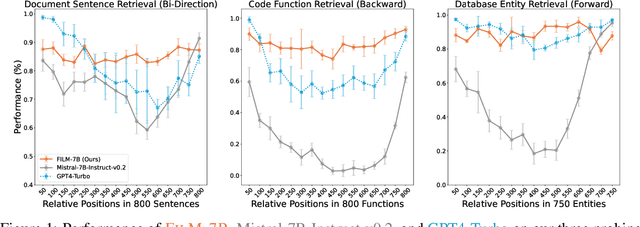

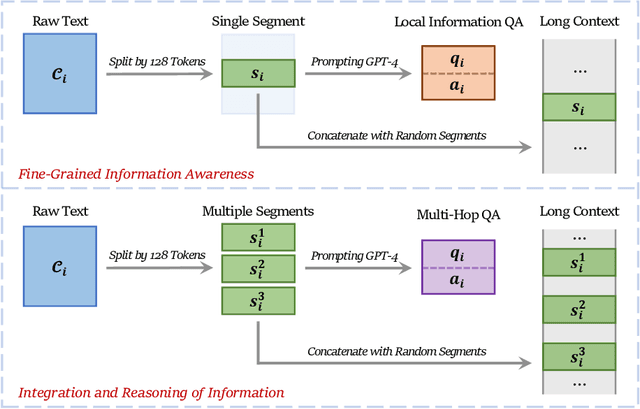
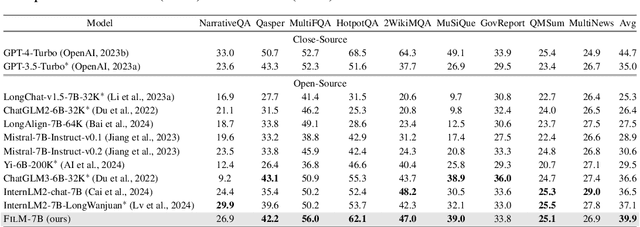
Abstract:While many contemporary large language models (LLMs) can process lengthy input, they still struggle to fully utilize information within the long context, known as the lost-in-the-middle challenge. We hypothesize that it stems from insufficient explicit supervision during the long-context training, which fails to emphasize that any position in a long context can hold crucial information. Based on this intuition, our study presents information-intensive (IN2) training, a purely data-driven solution to overcome lost-in-the-middle. Specifically, IN2 training leverages a synthesized long-context question-answer dataset, where the answer requires (1) fine-grained information awareness on a short segment (~128 tokens) within a synthesized long context (4K-32K tokens), and (2) the integration and reasoning of information from two or more short segments. Through applying this information-intensive training on Mistral-7B, we present FILM-7B (FILl-in-the-Middle). To thoroughly assess the ability of FILM-7B for utilizing long contexts, we design three probing tasks that encompass various context styles (document, code, and structured-data context) and information retrieval patterns (forward, backward, and bi-directional retrieval). The probing results demonstrate that FILM-7B can robustly retrieve information from different positions in its 32K context window. Beyond these probing tasks, FILM-7B significantly improves the performance on real-world long-context tasks (e.g., 23.5->26.9 F1 score on NarrativeQA), while maintaining a comparable performance on short-context tasks (e.g., 59.3->59.2 accuracy on MMLU). Github Link: https://github.com/microsoft/FILM.
 Add to Chrome
Add to Chrome Add to Firefox
Add to Firefox Add to Edge
Add to Edge